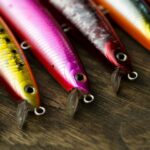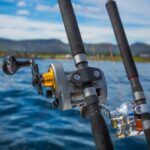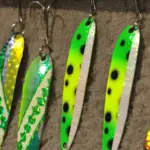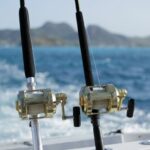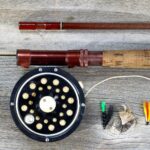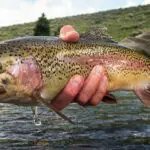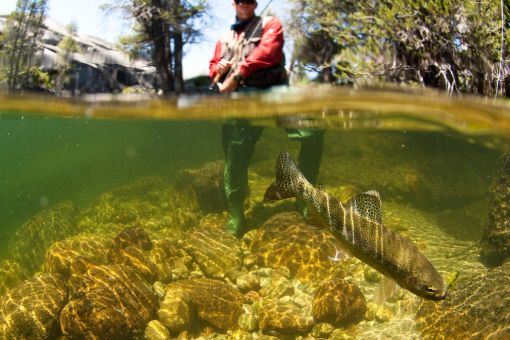
In a world where fishing has moved from a hunter-gatherer way of life to a competitive sport, we have seen massive changes in how we choose and use fishing gear. Some may say that the reel is the most essential aspect of the equipment, while others may argue that it is the bait, lure, or rod. I recently watched a segment on fishing lines, and it said that it is the most crucial part, but can fish see it?
Thicker lines and vivid colors are easier for fish to see than transparent ones. For example, dark green and red fishing lines are more visible in clear water, whereas white and light blue are more evident in dark or murky water. Fish can see all line types, but fluorocarbon is the least visible.
Numerous options are available on which fishing line is the best for avoiding fish sight. However, we should wonder if it makes a difference if the fish can see the line. Some may argue it hinders catching fish, whereas others may say it does not matter. We will look at the different lines and see what fishing lines are best if you don’t want fish to notice your lines.
What Types Of Fishing Line Can Fish See
From the start, we want to say that fish can see all line types. However, fishing lines come in different material types, each with benefits and drawbacks. There are basically 3 types of fishing lines most anglers will find in bait shops. Mono, fluoro, and braid. Each comes in various colors, thicknesses, and strength or pound test ratings.
It should be evident that thicker lines would be more visible than thinner lines. The same is true with vivid colors like bright pink, yellow, and red. Before we go into what lines fish can see, we need more information on the various lines first. Here’s an analysis of some of the most common types of fishing lines, and we will consider how well fish can see them:
Monofilament Fishing Lines
This single strand of extruded nylon material is the most common type of fishing line you will find. They are reasonably abrasion-resistant but less UV resistant. They can stretch up to 20%, making them great for that initial grab and pull. It’s also one of the most affordable options available. Monofilament lines are suitable for both freshwater and saltwater fishing.
Most avid anglers don’t use monofilament lines except for leaders.
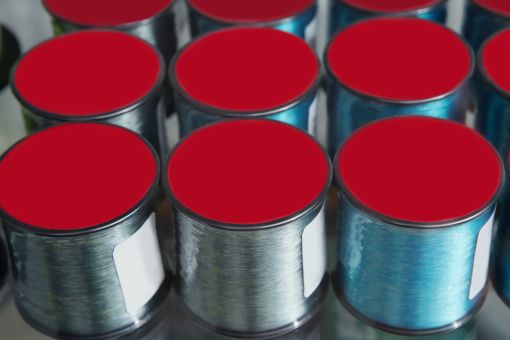
Pros:
- Most affordable and easily accessible from most big box and bait and tackle stores
- Spools smoothly on spinner and baitcaster reels
- Best shock absorbing because of stretchability
- Abrasion-resistant
- Being an extruded product, it is uniformly circular
- Very simple to tie most fishing knots and holds knots better
- More buoyant than other lines
- Cheapest fishing lines
Cons:
- Weakest type of line in per-pound tests
- Thicker than other lines of the same strength, causing it to take up more space on the spool
- The nylon material degrades over time in direct sunlight
- The line has a fair bit of memory making it prone to create bird’s nests and knots
- The stretchiness can make it difficult to detect bites
- Bad for bottom fishing because of buoyancy
The most common colors of monofilament include clear, green, blue, and red. Depending on the water type and clarity you are fishing will determine if fish can see the line. Many anglers tested these lines over the years, and the consensus is that you should use green mono in freshwater where the water is brown, murky, or green. Use clear, white, and blue in fresh and saltwater where the water is mostly clear.
When it comes to red mono, there are varied opinions. Some say that red is difficult to see underwater since the color red disappears in water that is between 10 and 15 feet. Although this is somewhat true that you cannot see red at that depth, the line does not disappear. It becomes black. That could be ok in brown, green, or murky water, but you can see a black line in clear water.
Fluorocarbon Fishing Lines
Fluorocarbon is extruded into a single strand like mono, but the material used differs. Polyvinylidene difluoride (PVDF) is a denser material for making fluorocarbon than monofilament’s nylon polyamides. This makes it thinner for the same pound-tested line and less visible in the water. Fluorocarbon lines are also more abrasion-resistant than monofilament lines.
They are great for finesse fishing and are commonly used for leader material in freshwater and saltwater fishing. It is excellent when you are looking for a fast-sinking line. Fluorocarbon fishing line comes mainly in clear or a light blue tint. They can stretch more than mono lines, but they need more force applied to them before it begins to stretch.
Pros:
- It sinks better than mono, so your bait gets to the bottom faster
- It needs more force to stretch than mono
- More sensitive, so you can feel bites better
- Excellent abrasion resistance
- Less visible than mono for the same pound test line
Cons:
- A stiffer line causes it to be less wieldy than mono lines
- More expensive than mono
- Tying knots is more complex, and most of the time, the line needs to be wet to get a good knot
- It has a lot of memory in the line making it harder to cast far
- Not good for topwater fishing
It should be noted that fluorocarbon lines are an upgraded version of mono. Therefore, anglers prefer to use it more often for leaders since this is the least visible for fish. In addition, it is more robust, less buoyant, and can take that initial grab force.
Braided Fishing Lines
This is a strong, thin line of multiple strands of synthetic material woven together. Materials like horse hair, linen fibers, silk, and cotton were used to make braided lines. Still, today they are mostly made from thin nylon lines woven into a pattern, making them incredibly strong. In addition, it has almost no stretching making them ideal for deep-water fishing, trolling, and catching large fish.
They are famed for saltwater fishing but can also be used in freshwater.
Pros:
- It has a smaller diameter than other lines of the same strength
- You can put more line onto the spool
- Sinks more quickly than mono and can cast further than most lines
- It does not degrade as fast in the sunshine as other line types
- There is almost no stretch, so you can feel it when a fish bites
- The lack of elasticity enables improved lure movement when trolling
- There is no line memory, which makes it less likely to kink or tangle
Cons:
- More expensive than other lines
- Knots untie easily
- Less abrasion resistant than mono
- It can be heavy because you can put a lot on a reel
When it comes to color, you have 2 options. High visibility and low visibility braided lines. The high visibility options have bright pinks, yellows, oranges, reds, and whites. In contrast, the low-visibility ones are more grey, blue, or camo. Some anglers believe braided lines are more challenging to see, but when you use high visibility colors, fish will see it.
Avid anglers usually use a braided line, providing the needed strength and casting distance. They will then use a mono or fluorocarbon line as the leader. This combination gives you a low visibility line at the lure or bait where the fish are while having the benefit of the angler seeing what their line does on their side.
Does It Matter If Fish Can See Your Line
Anglers would want to know if fish can see their line because they struggle to catch fish. However, no one will ask or worry if the fish can see the line if they pull in many fish. So maybe the line is not the problem as much as the lure, bait, or water temperature. However, some fish species are more cautious and line shy, for example, pike, trout, and sometimes bass.
Another idea to consider is if you are using a leader. When using a leader, it does not matter what color or type of line you have on your spool or reel. The fish will only see or be aware of the leader line closest to the bait or lure.
Active and most predatory fish don’t care about the line when acting impulsively. For example, if you are trolling for fish, they will act on the bait going quickly through the water and have no time to examine the line. So the idea is to create situations where you activate their impulse to eat. When the water is cold and the fish are lethargic, you will find it difficult to catch any fish, no matter what bait or line you have.

Here’s a breakdown of the different colors and their visibility underwater:
- White: This color is the hardest to see in clear water, as it merges in with the sky and surface of the water. It’s not recommended for fishing in clear water or for targeting shy fish. Most fish have a white underside, making it difficult for predatory fish to see them when looking up. So it stands to reason in water where you find fish with white bottoms, use a white line.
- Red and Yellow: These colors are easier to see above and underwater and unsuitable for fishing if you are worried that fish can see them. However, they will see it, so it is advised to use a leader that fits your watercolor. Again, these are more for the angler’s benefit than to hide from fish.
- Light Blue: This color is an excellent all-around option, as it’s somewhat invisible in most types of water.
- Dark Green: This color is the easiest to see underwater, particularly in clear water. It’s a good option for fishing in rivers or lakes with much vegetation and where the water is murky and dark.
The top fishing line for you will depend on your individual needs and the type of fishing you’ll be doing. Consider factors like the type of water you’ll be fishing in, the size of the fish you’re targeting, and your personal preferences when choosing a fishing line.
Consider How Fish Detect Food
Fish find their food differently depending on the type of water they are living in. Some fish detect their food through vibration, others through sight, sound, or smell. When the water is clear, those fish will rely on their eyesight. However, they will employ other means to detect their food if the water is murky or dark. The seasons also affect the number of food sources available to them.
Generally, most fish use their eyesight more than their other abilities to find food. They also act on survival and will compete with others in a populated area. Those fish that rely primarily on smell, like sharks, will move toward the food and then look at where it is. Other fish, like carp, taste or feel food with their mouth and then spit it out if it tastes or feels unnatural.
When something moves, they will quickly grab it before their neighbor gets it. If the fish population is sparse, you will find that they don’t have to contend with others, decreasing their bite responses. If they live in an area with vegetation like grass, your line will blend in with the other shapes. They will be unable to differentiate or detect your line.
The lateral line on many fish that runs on both sides from front to back allows fish to detect objects and vibrations in the water. This is how fish detect if something is moving in dark or murky water. They will pursue it and, when close enough, grab it. Likewise, when your line creates vibrations or “sings” in the water when reeling in, fish will detect it and move away.
Fish like bass are also curious when there is a splash in the water. That is why you will hear guys say when casting your lure for bass, wait till the splash ring disappears before reeling in. This will give the fish ample time to reach the splash spot and investigate or grab the bait. The line movement and vibration are then limited when you follow this tactic.
Why You Should Use Lines You Can Clearly See
Depending on the water body you are fishing in and the method of fishing, you will adapt and change tactics, lines, and bait according to the fish you are targeting. Most of the time, you would want a line you can see. If, for instance, you are trolling with 3-5 lines in the water, it will help to have different color lines so you can quickly identify which rod has a bite. You can then move it away from the other lines you can still see.
When fishing at night, it helps to have a line that you can see. You can even use specific lights that help illuminate your line at night. For example, a blacklight on a clear blue fluorescent line works great for night fishing. Will the fish see it? Maybe, but if they are hungry, it might not matter.
We are trying to convey that you should choose a line for your benefit. It helps you see what is happening with your line, and where the fish is going when it takes the bait. Essentially, it gives you more control and the ability to steer the fish. Use less visible lines only as leaders, or if you target skittish fish and line hiding is your primary aim.
FAQ
What Line Should You Choose For Toothy Fish?
Fish will definitely see wire leaders. However, it would be best to consider using a wire leader when targeting fish with teeth since mono, fluoro, or braid will not always stand up to the task. A substantial 30 – 40 pound tested Fluorocarbon line could work since it is pretty dense. Single-stranded stainless steel, titanium, and nylon-coated multi-strand wire are good options.
What Are The Marginal Gains In Fishing?
When it comes to anything you want to be successful at, you should work on marginal gains. The concept is easy if you break every aspect of your fishing down to its individual parts. You then marginally improve each aspect’s effectiveness allowing you to gain a lot of success overall. This is why you should work on using the best fishing line that fits your situation to give you the best result.
Conclusion
It should be evident that fish can see all fishing lines regardless of color or type. The question is whether they can recognize it as a threat or danger. There are loads of line-shaped objects in the water, and for fish to know that this particular line is a threat is unlikely. The combinations of lines, lures, water temperatures, water clarity, and fish population all play a part in being successful at fishing.
- Do You Need An Indicator For Nymph Fishing? - November 16, 2023
- Fishing Safety Tips For Families - September 25, 2023
- What Is The Best Time To Night Fish At A Lake? - September 18, 2023

